Temple of Garni › The Relationship Between the Greek Symposium & Poetry » Origins and History
Articles and Definitions › Contents
- Temple of Garni › Ancient History
- The Relationship Between the Greek Symposium & Poetry › Antique Origins
Ancient civilizations › Historical places, and their characters
Temple of Garni › Ancient History
Definition and Origins

The Temple of Garni (Armenian: “ Garnu tacar ”) is located in the village of Garni in Kotayk Province, Armenia, and it was once a pagan temple dedicated to the Armenian sun god Mihr. Built in the middle of the 1st century CE, the Temple of Garni remarkably survived the destruction of pagan temples following Armenia's conversion to Christianity in the 4th century CE, and countless invasions and earthquakes until its collapse in 1679 CE. After continuous excavations in the late 19th and early 20th centuries CE, the Temple of Garni was reconstructed between 1969-1975 CE. Today, it is the only free-standing Greco- Roman structure in Armenia and seen by many as a potent symbol of Armenia's classical past as well as its deep historical ties to the civilizations of Greece and Rome.
HISTORY OF THE TEMPLE
The Temple of Garni is situated in a very strategic location, on a cliff, overlooking a range of the Geghama mountains as well as the Azat River near the Ararat Plain. Located 30 km (19 mi) from Yerevan, the Temple of Garni is quite near Geghard Monastery, which is only 11 km (7 mi) up the Azat River, and not too far from the ancient capital of Artashat. The site was inhabited in prehistoric times, and there is evidence that it was also used by the Urartians between the 8th-6th centuries BCE.
IT SEEMS PROBABLE THAT THE TEMPLE WAS FIRST CONSTRUCTED UPON THE ORDERS OF KING TIRIDATES I OF ARMENIA SOMETIME AROUND 70-80 CE.
Although the historical record concerning the Temple of Garni is limited, it seems probable that the temple was first constructed upon the orders of King Tiridates I of Armenia (r. 52-58 CE; 62-88 CE) sometime around 70-80 CE. This stands in contradiction to the opinion of the great Armenian historian Movses Khorenatsi who attributed the Temple of Garni's construction to Tiridates the Great (r. 287 CE - c. 330 CE) - Armenia's first Christian king - in the 3rd century CE. Other academics contend that it was not a temple but rather a former tomb to one of the pro-Roman kings of Armenia who lived in the 2nd century CE. This argument is sustained by the structural similarities between Garni and several mausolea in Asia Minor.
Tiridates I is primarily remembered in Armenian history for his visit to Naples and Rome in order to meet Emperor Nero (r. 54-68 CE) in 66 CE. The founder of the Arsacid dynasty of Armenia (52-428 CE), Tiridates I was a skilled diplomat, devout Zoroastrian, and lover of the arts. Although the Roman historian Tacitus claimed that Tiridates I was interested in all things Roman (Tacitus, Annals 15.5), it is more likely that Tiridates' exposure to and interest in Greco-Roman culture was deeply rooted given the fact that his mother was Greek and that he spoke Greek fluently. Curiously, Tacitus references the Temple of Garni, denoting it as the “Castellum Gorneae.”
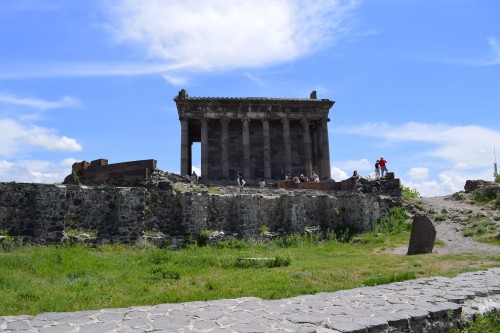
Side View of Garni Temple in Armenia
A Greek inscription uncovered by Martiros Saryan in 1945 CE at the Temple of Garni suggests that Tiridates I was the patron and founder of Garni Temple, but there are many possible interpretations and readings of this inscription. One interpretation cited by Dr. Vrej Nersessian translates the inscription as the following:
The Sun God Tiridates, uncontested king of Great Armenia built the temple and the impregnable fortress in the eleventh year of his reign when Mennieay was hazarapet [thousander, chiliarch] and Amateay was sparapet [general, commander]. (103)
The area surrounding the Temple of Garni functioned as a royal garrison and military fortress in ancient and medieval times. It was later surrounded by Roman baths dating from the 4th century CE in addition to a four-apsed church and a single-naved church, which both date from the 7th century CE. There remains considerable academic debate as to whether Garni functioned as a summer palace as well in Late Antiquity. Researchers are in agreement that there was also an immense defensive wall constructed of monolithic stones rather than mortar, which was built perhaps in the 1st century BCE. Many khachkars (memorial stele with a cross) are located beside the Temple of Garni. An Urartian cuneiform stone relating the conquest of the area surrounding Garni and dating to the reign of Argishti I (r. 785-763 BCE) is also positioned close to the temple.
After Armenia became Christian in the early 4th century CE, the Temple of Garni was spared thanks to the intercession of Princess Khosrovdoukht who was the sister of Tiridates the Great. At the time, Tiridates led a concerted effort to systematically destroy all of Armenia's ancient pagan temples. Due to its strategic importance, the area around the Temple of Garni was subjected to multiple invasions by Romans, Persians, Arabs, Byzantines, Turks, and the Mongols. The temple itself was repeatedly violated, and today visitors can see Arabic graffiti, which dates from the 9th-10th centuries CE.
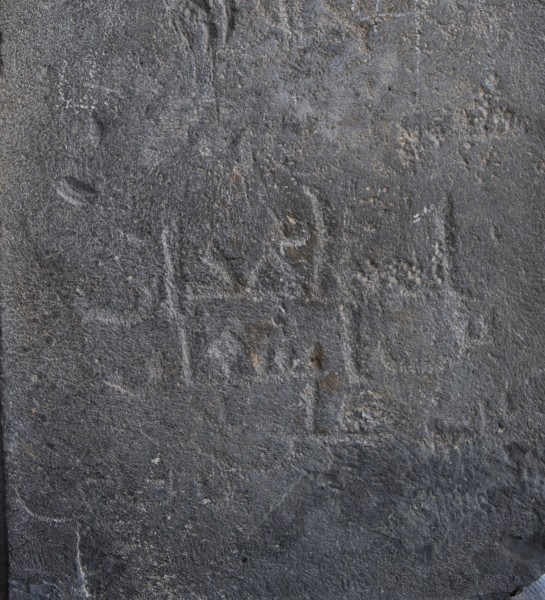
Arabic Graffiti at the Temple of Garni
The Ottoman Turks raided the environs of Garni in 1638 CE during the Ottoman–Safavid War of 1623–39 CE, causing much destruction. Following a catastrophic earthquake in 1679 CE, the Temple of Garni collapsed and was left in ruins for hundreds of years. It was only in the late 19th century CE that archaeologists began to explore the site, and it was Nikoraios Mar who took the initiative to amass and safeguard the stones of the fallen temple between 1909-1911 CE in the hopes of one day resurrecting the temple. Alexander Sarhinyan oversaw the restoration of the Temple of Garni between 1969-1975 CE while Armenia was under the control of the Soviet Union.
ARCHITECTURE
The Temple of Garni is the sole surviving pagan temple in Armenia and the only classical structure still standing in the country.Built on a podium, the temple is peripteral and oriented to the north. It is constructed of gray basalt that was quarried from the vicinity of Garni. The temple has 24 Ionic columns, which are 6.54 m (21.5 ft) high. Six are located in the front and the back parts of the temple, and eight on the sides. Some researchers believe that the columns originally came from Asia Minor and that they could symbolize the 24 hours of a day. The cella is about 7 m (23 ft) high, 8 m (26 ft) long, and 5 m (17 ft) wide. As it can only hold about 20-25 people inside, many historians and archaeologists believe it originally held a statue, perhaps of the sun god Mihr or Helios.
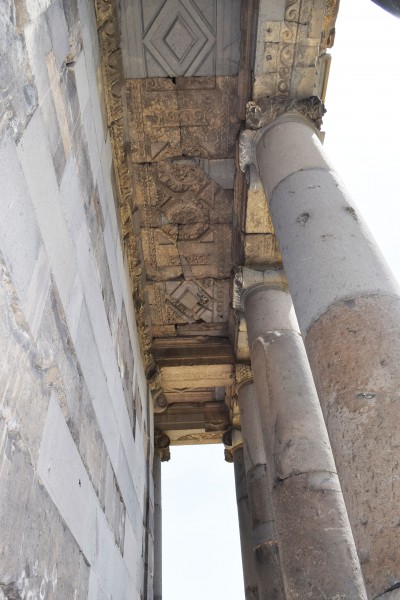
Ionic Columns at Temple of Garni
The equilibrium of elegant proportionality lends the Temple of Garni a concurrent impression of power and harmony. The temple is superbly decorated in the imperial Roman style. The architectural elements offer, however, certain variations that one recognizes in certain sculpted motifs, those representing lions in particular. The capitals themselves are singular; none are exactly identical with another. The friezes are dominated by acanthus leaves, which are sometimes mixed with laurels, oak leaves, and pomegranate trees.
The Roman baths found next to the Temple of Garni are built from brick and Armenian tuff (volcanic stone). They conform to the traditional layout found across the former Roman Empire and the Caucasus and are elegantly decorated with mosaics depicting mythological scenes.
This article was made possible with generous support from the National Association for Armenian Studies and Researchand the Knights of Vartan Fund for Armenian Studies.
The Relationship Between the Greek Symposium & Poetry › Antique Origins
Ancient Civilizations
The Ancient Greek symposium is often considered an important part of Greek culture, a place where the elite drank, feasted and indulged in sometimes decadent activities. Although such practices were present in symposia, the writing and performance of poetry is perhaps the most interesting and thought-provoking element of the ancient sympotic tradition.
This essay aims to investigate the interestingly varied relationship between the symposium and poetry by approaching it on a number of different levels: the first exploring poetry's capability to inform its reader about the symposium and its associated practises; the second probing poetic relationships with and similarities to other key sympotic components, such as wine; the third questioning the suitability of poetry as a source for establishing the nature of such a relationship.
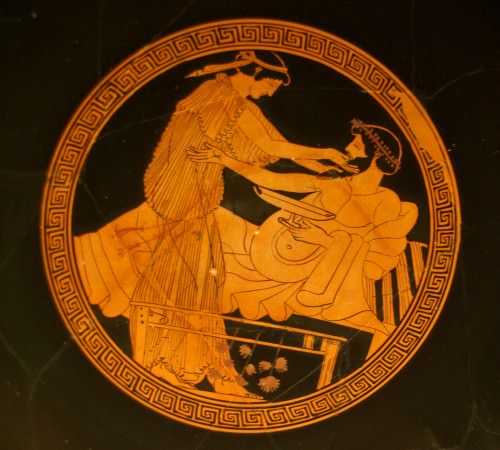
Symposiast & Hetairai
From a modern perspective, that the symposium was a context for the performance of literature immediately and incontrovertibly implies a connection between poetry and the symposium. This then raises questions of the nature of said relationship: did poetry simply sing of sympotic activity, opening up the exclusive and elusive world of the Ancient Greek elite?How was the environment of the symposium particularly suited to the performance of poetry, and did this setting determine or in any way influence the kind of poetry performed?
Xenophanes, a Greek philosopher, theologian, poet, and critic, provides a splendid account of sympotic customs, noting the setup of the wine mixing bowl, the food available, and the prayers and libations to the deities before proceedings begin, insinuating that there was a heavily ritualised character to the symposium. In addition, though writing almost a century earlier, Alcaeus, a Greek lyric poet, wrote the line, 'from Teian cups the wine drops fly,' which indicates the playing of drinking games of sorts. It is interesting to note the different times within which each poem was written; the large chronological gap between the two shows that the tradition of depicting sympotic events in poetry was not only maintained, but important.
'DEFEAT THE WEATHER; LIGHT A FIRE, MIX THE SWEET WINE UNSTINTINGLY AND PUT A NICE SOFT CUSHION BY MY HEAD.' ALCAEUS
Although in many cases, as examined above, sympotic poetry seemingly provides descriptions and depictions of activities and events during the symposium, it has been argued that pictures of moderate drinking parties may not necessarily mirror reality but are rather a guide as to how to drink 'properly'. Considering also that the symposium was considered a centre for the transmission of traditional values, it seems logical that poetry should reflect not only the happenings but also the aims and intentions of the symposium.
For example, Anacreon, writing in the 6th century BCE, provides not only guidance regarding the proper ratio of mixing water to wine: 'come boy, bring us a bowl so I can drink a sconce. Pour in ten ladlesful of water, five of wine, so I can bacchanize once more with no disgrace,' but he also advises on the manner in which one should consume wine, ' come now, this time let's drink not in this Scythian style with din and uproar, but sip to the sound of decent songs.' In addition, Alcaeus, a poet from around the 7th-6th centuries BCE, warns of the dangers of wine, 'if wine fetters the wits, often he hangs his head and blames himself, regretting what he's said, but its too late to take it back.'
The occurrence of such guiding themes in poetry written almost 100 years apart emphasizes their importance and hints that such a relationship between the symposium and poetry was strong and continuous.
These three instances demonstrate this poetic role and highlight a mutual exchange between the symposium and poetry; while the symposium may provide the subject matter, poetry can provide the constraints and guidance for such subject matter. This shows that already, although only following a brief investigation, the relationship between poetry and the symposium is more intricate than meets the eye.
It has been established that a key aspect of the relationship between the symposium and poetry is poetry's ability to depict sympotic activities - the 'seen' components of the symposium, so to speak. However, the relationship assumes a new dimension when one considers the portrayal of the 'invisible' sympotic atmosphere through, rather than imagery and words, the very nature of sympotic poetry. The symposium as an exclusive gathering of elites implies an intimate and sheltered environment for the recitation of poetry.
Pottery carrying depictions of the symposium show a keen focus on internal events amongst the participants, and an inward facing layout is suggested by Xenophanes, who points out 'the altar in the middle bedecked with flowers', which gives rise to the idea that the symposium was a gathering separate from the outside world. The repetition of this imagery in different kinds of sources lends strength and credibility to the case for an inwardly directed symposium. From here, parallels can be drawn between sympotic poetry and the arena in which it was performed for and written in.
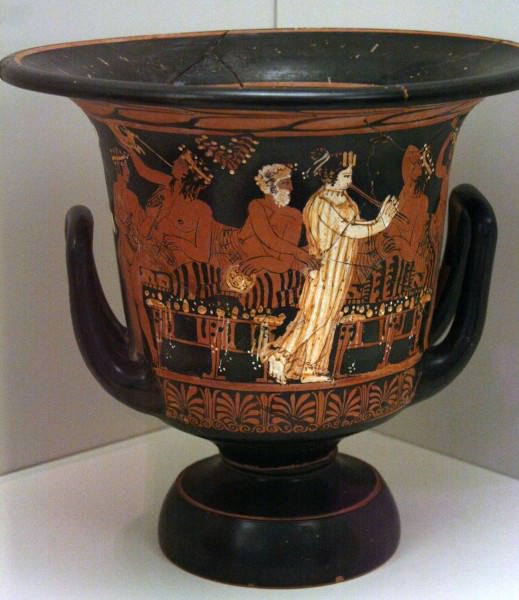
Scene from a Symposium
Exemplifying the notion of sympotic isolation, it has been suggested that Theognis, a sixth century BCE Greek lyric poet, saw the themes of sympotic poetry and the symposium as providing refuge from the corruption of Megara, which supports the idea of the sympotic environment as being very sheltered from the outside world. Similarly, although in a slightly lighter-hearted manner, Alcaeus shows the symposium to be an escape from the outside world, but in this case from the weather, 'defeat the weather; light a fire, mix the sweet wine unstintingly and put a nice soft cushion by my head.' Furthermore, although the earliest sympotic poetry may have actually been contemporary with early epic, the content of the respective genres varies widely, due in part perhaps to the different performance environments and audiences of each genre?
Having investigated the more straightforward features of the relationship between the symposium and poetry, the time has come to direct attention to its more subtle and elusive constituents. Possibly the most interesting fact about this increasingly intricate relationship, is that poetry finds itself not only associated with the symposium as a whole, but linked in a labyrinthine manner to key elements within the symposium itself, such as wine. In other words, the connections between poetry and the symposium represent relationships within a relationship.
It hardly needs to be said that wine was a key component of the symposium. What is curious is the way in which the characteristics of wine and poetry are closely related and in some cases interwoven. On the one hand, one could almost go so far as to argue that, poetry is the literary compliment of wine, and that in the context of the ancient symposium, poetry was approached in a manner not so far removed from the way in which wine was viewed. However, on the other, it could be claimed that poetry was the sympotic antithesis of wine, revealing a more complicated relationship between poetry and wine than may have previously been appreciated.
It is evident that many characteristics of wine and poetry are intimately linked in the symposium. Alcaeus remarks that 'wine puts cares out of mind,' and that 'wine is a window into a man' properties shared also with poetry, especially that within the sympotic context which played upon particularly pleasurable themes, as aforementioned. Although parallels between the effects of wine and poetry have begun to emerge, this is not to say that wine and poetry work in the same way. Parallels can also be drawn, establishing a relationship, between wine and the composition of poetry. The historian Whitmarsh states that solids and liquids are not the same as food and drink, which require artfulness and cultivation.
It is well established that wine was very much a cultivated and refined product, having been brought from outside into the home, drawing many parallels to the god Dionysos, a key player in the symposium. The writing and 'cultivation' of poetry by the author seems to reflect closely the winemaking process. Additionally, the heavily ritualised and controlled practice of mixing water with wine, mentioned previously in Anacreon's verse, can be interpreted as a mirroring of the careful art of fitting words into a regularly repeated meter then singing them to a tune of a similarly repetitive nature to the meter. Thus it is not unreasonable to suggest that poetry could in fact masquerade as the literary equivalent of wine.

Paestum painting, scene from a Symposium
Despite the appearance of a harmonious and close relationship between poetry and wine, it can be seen that while poetry may hypothetically offer itself as the literary equivalent of wine in the symposium context, it can simultaneously act as a literary antithesis to wine, almost as a sympotic antidote. The fact that poetry and wine share similar capabilities, as expressed above, raises the question of whether poetry could be interpreted as a medium providing all the benefits of wine, yet without the risk of social embarrassment.
The usefulness of ancient poetry as a source for studying the symposium cannot and should not be denied. However, it is important not to let this usefulness get in the way when trying to establish the relationship between the symposium and poetry, as the modern perspective of the relationship could cloud the ancient relationship. On the one hand, as shown above, poetry has a great deal to tell the reader, both implicitly and explicitly about the ancient symposium, demonstrating that it is a good source for establishing the relationship between the symposium and poetry.
Yet on the other hand, the fact that a relationship can be seen between poetry and the symposium without much in-depth investigation into the matter raises the question of whether it would be better to consider other sources, such as pottery for example, so as to gain a wider and clearer perspective on the relationship. Lastly, it is interesting to ask why poetry is considered such a suitable source for establishing the relationship between the symposium and poetry; is it because, like the symposium, poetry was a key element of Greek culture which endured through time, therefore, the modern scholar is keen to link the two together in the aim of figuring out their method of survival?
The relationship between poetry and the symposium was complex, increasingly so the deeper into individual sympotic elements one delves, finding more subtle connections and similarities all the time. There was also almost certainly a degree of mutual exchange between the two, with one influencing and inspiring the other and vice versa.
One thing in particular stands out; that interpretations of the relationship between poetry and the symposium will continue to change and evolve over time, in much the same way that poetry and the symposium can be seen to have helped one another develop in the ancient world. The fact that an active relationship between two aspects of Ancient Greek culture can still be seen today is very exciting.
LICENSE:
Article based on information obtained from these sources:with permission from the Website Ancient History Encyclopedia
Content is available under License Creative Commons: Attribution-NonCommercial-ShareAlike 3.0 Unported. CC-BY-NC-SA License